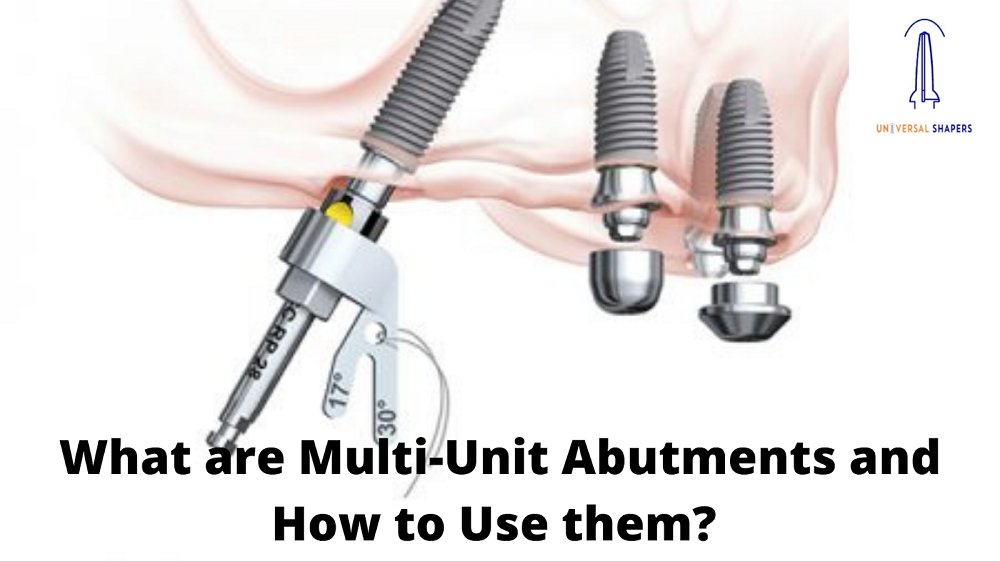Smile, let your teeth breathe!
The ongoing technological advancements are a great contribution to revolutionizing the world. And the dentistry sector hasn’t been spared. In the past few years, we have seen advancements in dental implant technologies and designs.
One of the areas that experienced technological advancement in dentistry is dental implants. So no doubt, a multi unit abutment is one of the topmost advancements for the dental industry. You can consider it as all-on-four dental implants.
Are you interested in knowing more regarding multi-unit abutment? If so, you are in the right place! Read on to understand the meaning of multi-unit abutments and their usage.
What is a multi-unit abutment?
A precious gift for your smile!
MUA (a multi-unit abutment) is a small connector piece. Dentists use it to join the dental implant to a dental prosthetic. When using multi-unit abutment, it is possible to switch out a dental prosthetic and there is no need to remove the entire implant.
MUA is specialized abutments help in coordination with full arch replacements as well as zygomatic dental implants. Another name of MUA is all-on-four dental implants.
Types of Multi-unit Abutment
Usually, there are two types of multi-unit abutment systems. The first is straight multi-unit abutments, and the second is angulated/angled multi-unit abutments. You have great flexibility in choosing among angled or straight MU abutments for a range of alternatives in prosthetic rehabilitation.
1. Straight Multi-Unit Abutments
It is a screw-retained prosthetic solution. Here the implant is placed at a less degree of divergence that ranges more than 40°.
2. Angled/Angulated Multi-Unit Abutments
Angled/Angulated multi-unit abutment is best whenever angulation correction is required. Here the implant body is placed at a divergent angle range up to 75° to 100°.
Angulated multi-unit abutments consist of 3 options.
- First is 9° degrees angulation having implants with a 55° divergence.
- The second is 17°/18° degrees angulation, having implants with a 75°divergence.
- And the third option is 30° degrees angulation, having implants with a 100° divergence.
Sizes
The multi-unit abutment is available in a wide range of angulations and sizes. The size totally depends on the kind of dental implant used by the dentist.
The regular angulations for a multi-unit abutment are 0°, 17°, 30°, and 45°. But the special sizes like 60° and 52.5° are also available in multi-unit abutment. Many angulations provide high flexibility while placing all-on-four implants.
Recommendation for MUA
In general, MUA is not needed for every kind of all-on-four dental implant surgery. There are many chances that your implant dentist might recommend or need the placement of a multi-unit abutment. It is because of the fact that patients with misalignments in their teeth need MUA. Fixing various MUAs with various angles helps to level up the restoration process.
One more reason your dentist might opt for multi-unit abutment is because of height disparities. In such cases, when there are height differences, lower implants get placed over the tissue. But taller abutments have to be placed deep in the bones. It is helpful for making all the abutments at the same height.
Well, this process balances the restoration in teeth and a more polished look. It maintains speaking and eating functions, and also makes sure the restoration lasts longer.
Pros And Cons of Multi-Unit Abutment
Take the best decision for your beautiful smile!
Just like other things, MUA has pros and cons too. So, you should make sure to discuss it with your implant dentist. Before finalising your implant, ask your dentist for every query.
Pros Of Multi-Unit Abutment
- MUA saves time and money. You don’t need a sinus lift while performing dental implants in the jaws.
- MUA angulation gives strong support for the dental prosthetic.
- You can use different implant systems while coordinating with each other.
Cons Of Multi-Unit Abutment
- Multi-unit abutments are small in size and consist of only a few threads. It is not useful because a few threads are hard to tighten.
- It gets loose after a time and requires tightening again.
How To Use a Multi-Unit Abutment?
Multi-unit abutment helps in converting dentures to an implant-retained prosthetic. The entire surgery can be done perfectly when you place the right multi-unit abutments and adjust the denture to the multi-unit abutments.
Once you decide not to instantly load implants, it will be better to take care of MUA. It is beneficial to seat the multi-unit abutments before any process.
For enhancing the final prosthetic’s fit, accuracy starts with the impression process having multi-units places. It will save you time and provide the best outcomes.
Final words
To sum up, you might have understood the usage and properties of multi-unit abutments (MUA). You will experience easy and predictable seating for the final restoration.
We recommend you to check out Universal Shapers. Here you can buy the best surgical bur kits and other dental implant equipment.
Complete care for your oral health!
